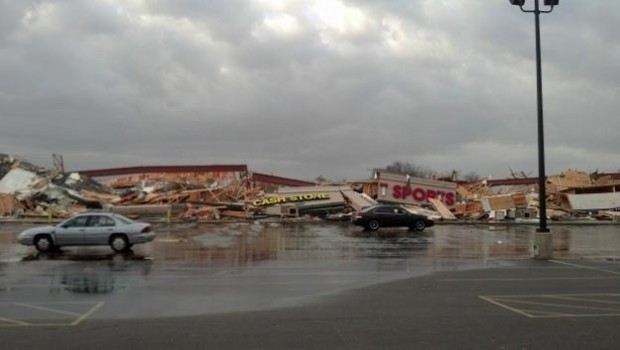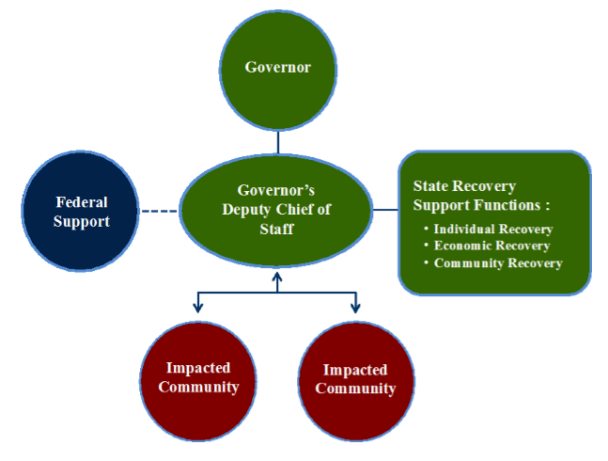Illinois 2012 Tornadoes
Learning Objective: Examine how the State of Illinois was able to re-prioritize existing funding and resources to meet the recovery needs of communities following a string of severe tornadoes in 2012 that did not meet Presidential disaster declaration requirements.
Part One
Background

Governor Quinn thought how he would prepare himself for the meeting he was about to adjourn. It was March 25, 2012, less than a month after he had woken up to the news that a series of severe tornadoes had impacted the southeastern corner of Illinois overnight, killing eight residents in the early hours of the morning.
After the tornadoes hit, the damage reports started arriving. Approximately 440 homes had been damaged, 176 of which were destroyed, in addition to the destruction of many businesses. One EF4 tornado (out of a possible EF0 to EF5 on the Fujita Scale), hit the City of Harrisburg and left a path of destruction approximately 200 yards wide. Governor Quinn activated the State Emergency Operations Center shortly after the tornado struck, flew down to survey the affected region, and began exploring all possible options to deliver relief and assistance to the impacted areas in southern Illinois.
His office had been busy coordinating with the Illinois Emergency Management Agency for weeks, and there was finally a feeling that the state was making progress on getting resources into the hands of the individuals and business owners that had lost everything to the storm. This was a great opportunity to test the recovery support structure his office had set up for state agencies that mirrored the federal recovery support functions, part of the state’s efforts to embrace the guidance in the National Disaster Recovery Framework (NDRF).
He was about to address the heads of state agencies to outline his plan for recovery support to the five impacted counties, and what each of their roles would be. Re-prioritizing funding to assist the tornado recovery would be a challenging task for many state agencies, as staff would be hesitant to lose funding for programs that were important to their agency’s objectives. This is one of the reasons all 23 Recovery Support Function (RSF) Coordinating and Primary/Supporting Agencies were being brought together at this meeting – so the governor could send a unified message to state agencies about the importance of helping communities recover, hopefully overcoming any internal reservations.
Challenges
Governor Quinn’s administration had applied for a Presidential Disaster Declaration for the damage caused by the tornadoes. However, it was determined that the disaster did not meet federal support requirements under the Stafford Act because Illinois itself was equipped to handle the response and recovery efforts. After receiving this notice on March 10, Governor Quinn moved quickly to apply for support through the U.S. Small Business Administration (SBA). That request was approved the next day and SBA issued a disaster declaration for nine counties, making them eligible for disaster assistance funding through low-interest, long-term loans specifically for economic damage.
Though the impacts were localized, the governor’s administration took recovery from the tornadoes seriously, recognizing that without state support, it would take these families and businesses far longer to recover. Though the state had experienced tornadoes before (at least 14 tornadoes per year since 1980), this tornado was the most devastating and had caused the highest number of casualties in Illinois since 2004. Governor Quinn hoped his plan for state interagency support would be effective in assisting the recovery efforts of the many local communities devastated by the February 29 storms.

Part Two
Actions

Once the immediate response needs were met and the communities were able to begin concentrating on rebuilding strategies, the governor’s office stepped in to help coordinate recovery assistance from all possible sources. He started by activating three Recovery Support Functions, designating a lead state agency for each. The state’s recovery coordination structure is shown in Figure 3 on the right. The governor charged the lead agencies with taking measures necessary to meet the community recovery goals, including re-prioritizing existing funding, for each of the three RSFs.
Individual Recovery – Lead: Illinois Emergency Management Agency
Economic Recovery – Lead: Illinois Department of Commerce and Economic Opportunity
Community Recovery – Lead: Illinois Department of Commerce and Economic Opportunity
Not only did Governor Quinn charge these lead agencies with coordinating individual, economic and community recovery, but his office asked all state agencies to work with partner federal agencies to bring additional types of support to the table, including Technical Assistance and “blue sky” programs that could assist. The roles and responsibilities the Governor’s Office and Illinois Emergency Management Agency designated for each supporting state agency, along with the federal agencies they partnered with for technical and programmatic assistance, are outlined in Appendix 1. Supporting State Agencies and Associated Federal Agencies.
Even without a Presidential Disaster Declaration, FEMA provided two technical specialists to support the state’s efforts to identify and coordinate recovery assistance to meet the goals of the impacted communities. The recovery specialists worked with the governor’s office, state agency leads, and other state staff to examine existing funding and budget requirements and identify opportunities for reprioritization of funds.
One type of federal funding source that was re-allocated to assist with the 2012 tornado recovery efforts was from the U.S. Department of Housing and Urban Development (HUD). Following a disaster, existing recipients of HUD’s Community Development Block Grants (CDBG) can shift funding priorities for unused funds remaining in the award to fund projects that support individual and community recovery needs. All approved projects must meet certain criteria and address specific program goals; however, CDBG funds are flexible and can be used to meet a variety of needs that arise after a subsequent incident.
Results
Just a week after Governor Quinn’s directive briefing to the state agencies, the heads of several agencies announced a relief package to help families, businesses, and local governments recover from the February 29 tornadoes. As a result of the coordination among state and federal stakeholders, approximately $13 million of existing state and federal program funding was reprioritized from other programs and applied to the 2012 tornado recovery efforts. This was a significant victory for Governor Quinn and for the impacted communities in the Harrisburg area.
“This assistance package offers real solutions for the long-term recovery effort in Harrisburg and other communities. Recovery from this tornado won’t happen overnight, but these resources will help residents and businesses of hard hit areas in southern Illinois begin to rebuild their lives.”
Governor Pat Quinn
In addition to the SBA loans and nearly $1.4 million of in-kind state assistance to the affected region, the state’s multi-agency relief package included:
- Up to $5 million from the Illinois Community Development Assistance Program (CDAP) to be used for public infrastructure projects, housing rehabilitation, and reconstruction efforts.
- $1 million from the Energy Efficiency Trust in partnership with Ameren Illinois.
- $750,000 in Workforce Investment Act grants to cover wages for dislocated workers to participate in disaster cleanup and structured work-based learning.
- Up to $2 million in USDA-RD business loans available through Illinois Finance Authority, in partnership with local banks, for the purchase of land, construction, or renovation of an industrial or commercial building or purchase of machinery and equipment.
- $1.58 million from the Illinois Department of Transportation for the completion of 21 municipal road improvements in Harrisburg
- Reimbursements of up to $1.5 million to local governments for some of their disaster-related expenses will be made through the Illinois Emergency Management Agency’s Disaster Response and Recovery Fund,
- Up to $1 million in committed federal HOME Funds from Illinois Housing Development Authority using the Single Family Owner Occupied Rehabilitation (SFOOR) Program.
- $400,000 in federal funding secured by Governor Quinn through the Delta Regional Authority to reimburse local governments for expenses related to debris removal.
After the announcement, Governor Quinn directed state agencies to continue providing support, outreach and technical assistance in impacted communities. State agency representatives continued to work to inform local leaders of the funding requirements, coordinate the state’s assistance and support the development of a unified recovery plan.
In 2013, severe tornadoes once again struck Illinois. While some communities were eligible for federal assistance this time, the knowledge and experience gained by state agencies in 2012 was directly applicable to the disaster recovery efforts in 2013.
Lessons Learned
- Senior elected leadership must make clear their intent to redirect funding to support impacted communities at the outset, as non-Stafford Act support is primarily accomplished by re-prioritizing funds and personnel from existing programs.
- Collaboration and coordination among federal subject matter experts, state leadership and state agency representatives was key to finding an effective funding solution.
- Understanding how currently available programs (both state and federal) can support disaster recovery is essential following non-Stafford Act and trying to determine what resources can be applied.
- Technical assistance is often key to successfully supporting recovery operations, in addition to programmatic resources. The establishment of state subject matter expert strike teams to support local impact assessments, recovery planning and resource identification should be considered best practice.
Follow up with the FEMA Guidance Development Office
The Guidance Development Office (GDO) develops and distributes FEMA’s Interagency Recovery Coordination (IRC) case studies. Our team would appreciate your feedback on these case studies and accompanying teaching notes. To get in contact with our team, please email FEMA-RECOVERY-ICD-GDO@fema.dhs.gov.
Case Study Downloads
Illinois Tornadoes Case Study
Citations

